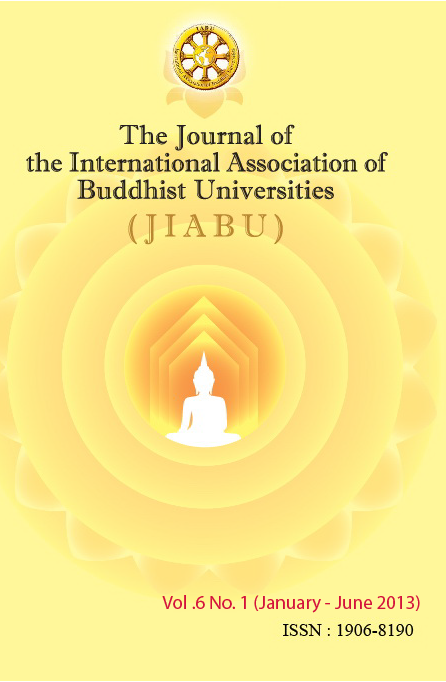Noble Truths versus Dependent Origination
Main Article Content
Abstract
The controversy regarding the central teaching of the Buddha seems to have not yet been solved with a consensus of opinion. The modern scholars of Buddhist Studies are also divided on this matter. Karunaratne, being one among them, points out Childers, Reischauer, Coppleston, Mrs. Rhys Davids, Law, Ayyaswamy, Tucci, Hamilton, Stcherbatsky, and Murti were of the opinion that the central teaching of the Buddha is the Dependent Origination (Paticcasamuppada).
Article Details
How to Cite
Abeynayake, O. (2019). Noble Truths versus Dependent Origination. The Journal of International Association of Buddhist Universities (JIABU), 6(1), 29–42. retrieved from https://so06.tci-thaijo.org/index.php/Jiabu/article/view/217823
Issue
Section
Article
Views and opinions expressed in the articles published by The Journal of the International Association of Buddhist Universities (JIABU), are of responsibility by such authors but not the editors and do not necessarily reflect those of the editors.
References
This paper was presented as the Keynote Speech to the 2nd International Association of
Buddhist Universities Conference on Buddhist Philosophy & Praxis, on 1 June 2012. It is
reproduced here, for a wider audience.
Kaunaratne, W.S., The Theory of Causality in Buddhism, Deepani Printers, Sri Lanka,
1988, footnote 1, p. 63
Kalupahana, D.J., Causality, The Central Philosophy of Buddhism, Honolulu, 1975Grimm, George, The Doctrine of Buddhism, Delhi, 1973
Rahula, Walpola, What the Buddha Taught, Bedford, 1967
Story, Francis, The Four Noble Truths, Kandy, Sri Lanka, Wheel Publications, Nos.
34/35 & Gunaratna, V.F., The Significance of the Four Noble Truths, Wheel Publications,
Kandy, Sri Lanka, No. 133
Nyanatiloka, Buddhist Dictionary, BPS, Kandy, Sri Lanka, 1980
Vinaya (=V) I, 11
MajjhimanikƘya (=MN) I, 167-8
V.I, 4-5; MN.I, 167
V.I, 11
DīghanikƘya (=DN) II, 55; SanyuttanikƘya (=SN) II, 92
MN. I, 190-1; II, 32
V.I, 16, 18; II, 156; DN. I, 110; MN. I, 380; AnguttaranikƘya II, 186; IV, 197
DN. I, 97; MN. I, 165-167
DN. II, 45ff
SN. II, 6
DN. II, 26ff
Vibhanga (=Vbh), 99-112
Pugganapaññatti, 2
KathƘvatthu (=Katha), 322
Vbh., 158-192
Katha., 319
Nyanatiloka, Guide through the Abhidhammapiṭaka, 3rd Edition, Kandy, Sri Lanka,
1971, p. 30
AtthasƘlinī, 13-14
PaṭisambhidƘmagga AṭṭhakathƘ I, 1, 9; III, 703
Buddhist Universities Conference on Buddhist Philosophy & Praxis, on 1 June 2012. It is
reproduced here, for a wider audience.
Kaunaratne, W.S., The Theory of Causality in Buddhism, Deepani Printers, Sri Lanka,
1988, footnote 1, p. 63
Kalupahana, D.J., Causality, The Central Philosophy of Buddhism, Honolulu, 1975Grimm, George, The Doctrine of Buddhism, Delhi, 1973
Rahula, Walpola, What the Buddha Taught, Bedford, 1967
Story, Francis, The Four Noble Truths, Kandy, Sri Lanka, Wheel Publications, Nos.
34/35 & Gunaratna, V.F., The Significance of the Four Noble Truths, Wheel Publications,
Kandy, Sri Lanka, No. 133
Nyanatiloka, Buddhist Dictionary, BPS, Kandy, Sri Lanka, 1980
Vinaya (=V) I, 11
MajjhimanikƘya (=MN) I, 167-8
V.I, 4-5; MN.I, 167
V.I, 11
DīghanikƘya (=DN) II, 55; SanyuttanikƘya (=SN) II, 92
MN. I, 190-1; II, 32
V.I, 16, 18; II, 156; DN. I, 110; MN. I, 380; AnguttaranikƘya II, 186; IV, 197
DN. I, 97; MN. I, 165-167
DN. II, 45ff
SN. II, 6
DN. II, 26ff
Vibhanga (=Vbh), 99-112
Pugganapaññatti, 2
KathƘvatthu (=Katha), 322
Vbh., 158-192
Katha., 319
Nyanatiloka, Guide through the Abhidhammapiṭaka, 3rd Edition, Kandy, Sri Lanka,
1971, p. 30
AtthasƘlinī, 13-14
PaṭisambhidƘmagga AṭṭhakathƘ I, 1, 9; III, 703


